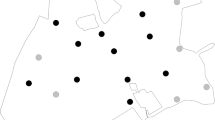Summary
The social organization of woodchucks (Marmota monax) in southeast Ohio was studied at two sites, at one for two 2 years (1979–1980) and the other for 3 years (1981–1983). Spatial organization was determined by trapping and radio tracking. The home ranges of adult females did not overlap in the early spring but during late spring and summer there was some overlap (<10%) as females expanded their home ranges. Adult females tended to occupy the same home range in consecutive years. Some adult males occupied well-defined home ranges that did not overlap the home ranges of other males but did overlap extensively the home range of one to three adult females. These males tended to occupy the same home range in consecutive years. Infants used the same home range of their dam until about 2–3 months of age when most males and females apparently dispersed. About 35% of the juvenile females did not disperse until their second spring, just before their mother's new litter first emerged from their burrow. The average social group consisted of an adult male with two female kin groups comprising an adult female, an offspring (usually female) of the previous year, and the young of the year. Interactions within the kin group and with the adult male were relatively frequent and generally amicable. Interactions between kin groups both within and between different social groups were relatively rare and agonistic. The social organization of woodchucks in Ohio differs from that described in previous studies of woodchucks elsewhere and from that predicted by current models proposed by others on the evolution of social organization of marmots.
Similar content being viewed by others
References
Anthony M (1962) Activity and behavior of the woodchuck in southern Illinois. Occas Pap CC Adams Center Ecol Studies 6:1–25
Armitage KB (1962) Social behavior of a colony of the yellow-bellied marmot (Marmota flaviventris). Anim Behav 10:319–331
Armitage KB (1981) Sociality as a life-history tactic of ground squirrels. Oecologia 48:36–49
Armitage KB (1984) Recruitment in yellow-bellied marmot populations: kinship, philopatry and individual variability. In: Murie JO, Michener GR (eds) Biology of ground-dwelling squirrels. Univ of Nebraska Press, Lincoln, pp 375–403
Armitage KB (1986) Marmot polygyny revisited: determinants of male and female reproductive strategies. In: Rubenstein DS, Wrangham RW (eds) Ecology of social evolution: field studies of birds and mammals. Princeton Univ Press, Princeton, pp 303–331
Armitage KB (1988) Resources and social organization of ground-dwelling squirrels. In: Slobodchikoff CN (ed) The ecology of social behavior. Academic Press, New York, pp 131–155
Armitage KB, Downhower JF (1974) Demography of yellow-bellied marmot populations. Ecology 55:1233–1245
Armitage KB, Johns DW (1982) Kinship, reproductive strategies and social dynamics of yellow-bellied marmots. Behav Ecol Sociobiol 11:55–63
Armitage KB, Downhower JF, Svendsen GE (1976) Seasonal changes in the weights of marmots. Am Midi Nat 96:36–51
Arnold W (1990a) The evolution of marmot sociality: I. Why disperse late? Behav Ecol Sociobiol 27:229–237
Arnold W (1990b) The evolution of marmot sociality: II. Costs and benefits of joint hibernation. Behav Ecol Sociobiol 27:239–246
Barash DP (1973) The social behavior of the Olympic marmot. Anim Behav Monogr 6:171–249
Barash DP (1974a) The evolution of marmot societies: a general theory. Science 85:415–420
Barash DP (1974b) The social behavior of the hoary marmot (Marmota caligata). Anim Behav 22:256–261
Barash DP (1989) Marmots, social behavior and ecology. Stanford Univ Press, California
Bronson FH (1963) Some correlates of interaction rates in natural populations of woodchucks. Ecol 44:637–644
Bronson FH (1964) Agonistic behavior of woodchucks. Anim Behav 12:470–478
Brown JL, Orians GH (1970) Spacing behavior in mobile animals. Annu Rev Ecol Syst 1:239–262
Davis DE (1981) Mechanism for decline in a woodchuck population. J Wildl Manage 45:658–668
Downhower JF, Armitage KB (1981) Dispersal of yearling yellow-bellied marmots (Marmota flaviventris). Anim Behav 29:1064–1069
Elliot PF (1975) Longevity and the evolution of polygamy. Am Nat 109:281–287
Ferron J, Quellet JP (1989) Temporal and intersexual variations in use of space in regard to social organization in the woodchuck (Marmota monax). Can J Zool 67:1642–1649
Grizzell RA (1955) A study of the southern woodchuck Marmota monax monax. Am Midi Nat 53:257–293
Hamilton WJ (1934) The life history of the rufescent woodchuck. Ann Carnegie Mus 23:85–178
Meier PT (1985) Behavioral ecology, social organization and mating system of woodchucks (Marmota monax) in southeast Ohio. Ph D Diss, Ohio Univ, Athens, Ohio
Michener GR (1983) Kin identification, matriarchies, and the evolution of sociality in ground dwelling sciurids. In: Eisenberg J, Kleiman D (eds) Recent advances in mammalian behavior. (Spec Publ Amer Soc Mammal 7) pp 528–571
Snyder RL, Christian JJ (1960) Reproductive cycle and litter size in the woodchuck. Ecology 41:647–656
Snyder RL, Davis DE, Christian JJ (1961) Seasonal changes in the weights of woodchucks. J Mammal 42:297–312
Vos A de, Gellespie DI (1960) A study of woodchucks on an Ontario farm. Can Field Nat 74:140–145
Author information
Authors and Affiliations
Rights and permissions
About this article
Cite this article
Meier, P.T. Social organization of woodchucks (Marmota monax). Behav Ecol Sociobiol 31, 393–400 (1992). https://doi.org/10.1007/BF00170606
Received:
Accepted:
Issue Date:
DOI: https://doi.org/10.1007/BF00170606




